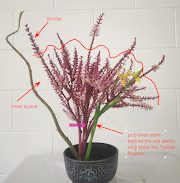Pattern 1 - Task, 1 August 2020
Topic: Pattern 1
✽ Ikebana Aesthetics Program - Zoom Ikebana Dojo
✽ Video Tutorial: Please subscribe to our Youtube Channel.
Pattern is just like sugar in Japanese cuisine. While it is often used, it is often disguised. When it is applied particularly by a master, it is hard to recognise.
Pattern is a regular arrangement of repeated (or alternated) elements or motifs. In Ikebana you may arrange shapes, lines, or colours repeatedly to create an interesting effect. Pattern may be sometimes associated with movement.
One of the best samples using pattern is Irises (National Treasure) by Korin Ogata.
Ogata Korin, died 1716 / Public domain
https://commons.wikimedia.org/wiki/File:KORIN-Irises-R.jpg

In Pattern 1, we practice making very obvious patterns. Learn how easy it is to use pattern in your design and to make your design so sophisticated and poetic.
For more about Pattern in ikebana, refer to a short essay, "Introduction to Ikebana Aesthetics" by Dr Shoso Shimbo (available shortly in English & Japanese).
Task
1. Make a group of 3 flowers, forming an asymmetrical triangle.2. Make two other groups forming a similar shape.
3. Arrange those 3 triangles as you like and make them a focal point of your design.
What You Need
1. secateurs2. kenzan or florist foam or wire packed container (see a task for Balance 1)
3. container - any include a cup.
4. flower materials:
a. Nine stems of Billy Buttons or any other flowers. Flowers with delicate stem such as Cosmos, Freesia and Allium are ideal to practice this topic.
b. Two or three leaves such as Canna Lily, Caladium, or any other plants.
Flower materials are guide only. You can choose any other materials as long as you focus on the topic.
3. container - any include a cup.
4. flower materials:
a. Nine stems of Billy Buttons or any other flowers. Flowers with delicate stem such as Cosmos, Freesia and Allium are ideal to practice this topic.
b. Two or three leaves such as Canna Lily, Caladium, or any other plants.
Flower materials are guide only. You can choose any other materials as long as you focus on the topic.
2. Make two other groups forming a similar shape. Arrange those 3 triangles as you like and make them a focal point of your design. In the sample, those triangles are set high above the container. To emphasise those triangles, the focal point of the arrangement, there is a large space around them.
3. Prepare the leaves. Manipulate them if you want to. In the sample, a florist wire was attached at the back of each leaf so that it can be bent easily.

4. Fix the leaves. Their function is to connect the focal point, the 3 triangles and the container.
5. Add flowers or foliage if you like.
2. Join Zoom Ikebana Dojo on 1 August 2020. Enjoy friendly feedback from our facilitator and other participants.
3. Post your work to Ikebana Gallery Award.





























